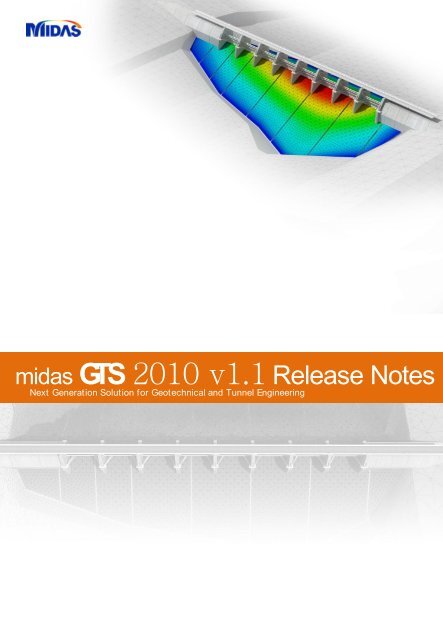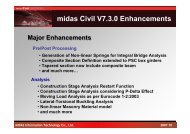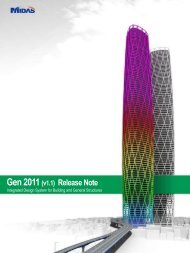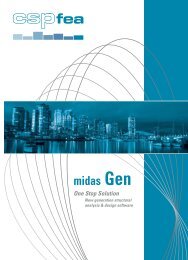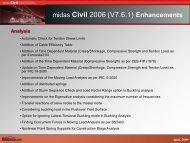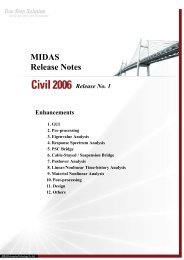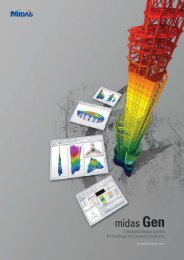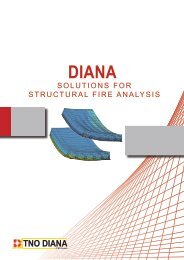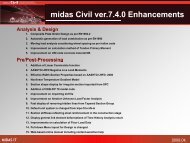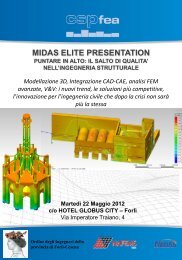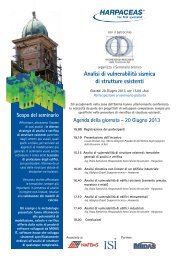midas GTS Release Note midas GTS 2010 v1.1Release ... - CSP Fea
midas GTS Release Note midas GTS 2010 v1.1Release ... - CSP Fea
midas GTS Release Note midas GTS 2010 v1.1Release ... - CSP Fea
- No tags were found...
You also want an ePaper? Increase the reach of your titles
YUMPU automatically turns print PDFs into web optimized ePapers that Google loves.
<strong>midas</strong> <strong>GTS</strong> <strong>2010</strong> v1.1 <strong>Release</strong> <strong>Note</strong>sNext Generation Solution for Geotechnical and Tunnel Engineering<strong>midas</strong> <strong>GTS</strong> <strong>Release</strong> <strong>Note</strong>Next Generation Solution for Geotechnical and Tunnel Engineering
Enhancements• Pre Processing1. File Preview & Status Bar2. Project Settings3. Works Tree <strong>Fea</strong>ture4. Check <strong>Note</strong> <strong>Fea</strong>ture5. Check Mesh <strong>Fea</strong>ture6. Divide Mesh Set by Surface7. Gauging Element <strong>Fea</strong>ture8. Seepage Face9. Water Level for Mesh Set10. Anchor Modeling Wizard567891011121314• Analysis1. 1D Equivalent Linear Analysis2. Analysis Speed Enhanced3. Arc Length Method4. High Order Beam Element5. Mohr-Coulomb model Tension Cut-off6. Cam Clay Model7. Permeability Coefficient Range15161718191920
Enhancements8. Automatic Consideration of Hydrostatic Pressure9. Seepage Effect in Seepage-Stress Semi CoupledAnalysis10. Transient Seepage-Stress Coupled Analysis11. Initial Stress Calculation with Ko Method12. Interface / Pile Elements in Dynamic Analysis202121212113. Convergence Criterion in Non-linear and ConstructionStage Analysis2214. Output Format for Nonlinear, Construction Stage andSeepage Analysis Results23• Post Processing1. Opening Analysis Result File2. Post Process Graphics Performance Enhanced3. 1D (Beam / Truss) Element Axial Force Output4. Beam Element Coordinate System (2D Modeling)5. Seepage-Stress Coupled Analysis Results6. Consolidation Analysis Results7. Time History Analysis Results8. Clipping Plane9. Combination / Envelope Results242526272829303132
Enhancements10. Table Output of Analysis Results3311. Analysis Case Combinations and Result ComponentCombination12. Table Output for Summation of Reactions13. Report Function Modification 114. Result Function Modification 215. Project to Element Surface3434343434
<strong>midas</strong><strong>GTS</strong>Enhancements <strong>midas</strong> <strong>GTS</strong> <strong>2010</strong> v1.1 <strong>Release</strong> <strong>Note</strong>s1. File Preview & Status BarUpgrade Contents• Information related to an existing model, for instance the shape of the model, the number of elements andnodes, the type of analysis case, the existence of analysis result file, etc., can be previewed before openingthe model file.• Model file results can be either read or unread prior to opening files.Effects & Usage• Significantly reduce opening file time by visually viewing the file in advance.• Allow opening the model file only (without opening the analysis result file together), reducing the loading timewhen the analysis result is not required.• File > Open• Model > Boundaries > Point Spring Support Table• Number of Nodes5 / 34
<strong>midas</strong><strong>GTS</strong>Enhancements <strong>midas</strong> <strong>GTS</strong> <strong>2010</strong> v1.1 <strong>Release</strong> <strong>Note</strong>s2. Project SettingsModified Contents• Model types of 2D and Axisymmetric have analysis constraints fixed in X-Y plane only.gravity direction is fixed in the Y-direction.As a result, the• Model files created in previous versions of <strong>GTS</strong> with different analysis constraints will automatically updatethe loads, boundary conditions, and geometry definitions to be compatible in <strong>GTS</strong> <strong>2010</strong> environment.Message box will appear to indicate any changes.• File > Project SettingProject Settings (<strong>GTS</strong> V1.1)Project Settings (V300)Warning Message (<strong>GTS</strong> V1.1)6 / 34
<strong>midas</strong><strong>GTS</strong>Enhancements <strong>midas</strong> <strong>GTS</strong> <strong>2010</strong> v1.1 <strong>Release</strong> <strong>Note</strong>s3. Works Tree New <strong>Fea</strong>tureUpgrade Contents• Friendly graphical user interface that enables users to access data more readily.• Newly added features such as “color coding” system and checkboxes for better data handling.* Automatic report not supported, accordingly Report Works removed (in a later version, new Report functionwill be supported)Effects & Usage• An improved management GUI that separates the modeling, analysis, and post processor data.items can accessed quickly by clicking feature tabs.These• Mesh set management provides easier work control (auto-grouping, modification by group, show/hide, etc.)and Property window. <strong>Note</strong> : Due to this feature, “Register Each Solid Independently” has been removed.• Model, Analysis, Post-Works Tree• Model > Boundaries > Point Spring Support Table7 / 34
<strong>midas</strong><strong>GTS</strong>Enhancements <strong>midas</strong> <strong>GTS</strong> <strong>2010</strong> v1.1 <strong>Release</strong> <strong>Note</strong>s4. Check <strong>Note</strong> <strong>Fea</strong>tureUpgrade Contents• Snapshots of a model can be saved and managed in the Model-Works Tress.• In the Check note environment, markups and comments can be made for better QA/QC procedure.Effects & Usage• Enable easy management of models for later review, by capturing and saving important parts• Easily report technical support by directly sending an email from the software (no need to capture a screenor to describe a problem)• Model-Works Tree > Check <strong>Note</strong>Check <strong>Note</strong>• Model > Boundaries > Point Spring Support Table8 / 34
<strong>midas</strong><strong>GTS</strong>Enhancements <strong>midas</strong> <strong>GTS</strong> <strong>2010</strong> v1.1 <strong>Release</strong> <strong>Note</strong>s5. Check Mesh <strong>Fea</strong>tureUpgrade Contents• New “Check Mesh” feature enables to identify clamped elements in 3D elements specifically used for CFDanalysis.Effects & Usage• Thinnest 3D elements along the outer edges are identified. For proper CFD modeling the clamped elementsmust be refined in order to obtain accurate results.• Mesh > Check Mesh > Clamped Element(Purple)Generated ModelCheck Mesh – Clamped ElementClamped Element verification9 / 34
<strong>midas</strong><strong>GTS</strong>Enhancements <strong>midas</strong> <strong>GTS</strong> <strong>2010</strong> v1.1 <strong>Release</strong> <strong>Note</strong>s6. Divide Mesh Set by SurfaceUpgrade Contents• Meshed 3D models can now be divided based on selected surface or user defined 3-point plane.Effects & Usage• Increase working efficiency by generating a mesh set without considering the location of each stratum or thegeometry profile, and then directly dividing the mesh set without modifying the geometry• Improved mesh set management by selecting specific mesh elements and assigning them as anindependent mesh set.• Mesh > Mesh Set > Divide Mesh Set by SurfaceDivide Mesh Set (Before)Divide Mesh Set by SurfaceDivide Mesh Set (After)10 / 34
<strong>midas</strong><strong>GTS</strong>Enhancements <strong>midas</strong> <strong>GTS</strong> <strong>2010</strong> v1.1 <strong>Release</strong> <strong>Note</strong>s7. Gauging Element <strong>Fea</strong>tureUpgrade Contents• Gauging Element feature supports extracting structural elements (referred to gauging element) from 3D solids.• Gauging elements can be used to assess member forces, which cannot be checked from the 3D solids.Effects & Usage• In a 3D model, gauging elements from a solid can be assigned a gauging element property in order toassess moments and shear forces.• Model > Element > Create Gauging ElementGauging Element Generation각 요소망에 지하수위 정의Gauging Element Results11 / 34
<strong>midas</strong><strong>GTS</strong>Enhancements <strong>midas</strong> <strong>GTS</strong> <strong>2010</strong> v1.1 <strong>Release</strong> <strong>Note</strong>s8. Seepage FaceUpgrade Contents• Model > Boundary > Seepage Face has replaced „Review Boundary based on Seepage Conditions‟ under„Nodal Flux Boundary‟.Usage• Pressure head value defines a review boundary which will allow the solver to determine the appropriatenodes that have flow or no flow.• This feature can either be applied to the geometry or element level.• Model > Boundary > Seepage FaceReview Boundary(V300)Seepage Face(V1.1)12 / 34
<strong>midas</strong><strong>GTS</strong>Enhancements <strong>midas</strong> <strong>GTS</strong> <strong>2010</strong> v1.1 <strong>Release</strong> <strong>Note</strong>s9. Water Level for Mesh SetUpgrade Contents• Support a separate water level for each mesh set.• Support spatial variation of water level along construction stages.Effects & Usage• Enables modeling of dewatering inside excavations in a friendly manner• Enables assignment of water level per stratum that is useful confined aquifer modeling.• Model > Construction Stage > Define Construction StageEach mesh set water level DefinitionConfined/Unconfined aquifer layers13 / 34
<strong>midas</strong><strong>GTS</strong>Enhancements <strong>midas</strong> <strong>GTS</strong> <strong>2010</strong> v1.1 <strong>Release</strong> <strong>Note</strong>s10. Anchor Modeling WizardUpgrade Contents• Support Anchor Modeling Wizard in 2D and 3D modelsEffects & Usage• Provide easy modeling of anchor (no need for geometric modeling)• Automatically generate mesh using input data, from one dialogue box, for material, section, angle, ungroutedlength, grouted length, etc.• Prevent singular error during analysis by automatically generating the mesh in the form of an EmbeddedTruss.• Model > Anchor Modeling WizardAnchor modelUpside-down T-shape sectionL-shape sectionAnchor Wizard14 / 34
<strong>midas</strong><strong>GTS</strong>Enhancements <strong>midas</strong> <strong>GTS</strong> <strong>2010</strong> v1.1 <strong>Release</strong> <strong>Note</strong>sAnalysis1. 1D Equivalent Linear AnalysisUpgrade Contents• Support ground response analysis using 1D equivalent linear analysis• Support Free Field analysis (response analysis of unexcavated ground, where no structure is constructed )Effects & Usage• Useful for estimating ground vibration, calculating dynamic stress and strain for liquefaction evaluation, anddetermining seismic load• Obtain essential data for seismic analysis by offering the same analysis functions as Shake-type software• Tool > Free Field AnalysisPreview of Ground LayersGround layer formulationStrain Compatible Property FunctionStress-strain graph15 / 34
<strong>midas</strong><strong>GTS</strong>Enhancements <strong>midas</strong> <strong>GTS</strong> <strong>2010</strong> v1.1 <strong>Release</strong> <strong>Note</strong>s2. Analysis Speed EnhancedUpgrade Contents• Support 64-bit OS & multi-core parallel system in nonlinear, construction-stage and seepage analysis.• The Multi Frontal Sparse Gaussian, Iterative Solver, and new direct sparse solver Intel® PARADISO cansupport up to 8 processors.Effects & Usage• Provide improved analysis performance using Multi-Frontal Sparse Gaussian Solver• Substantially increase analysis speed for large models (usually 2 to 3 times faster than V300) by utilizing thefull RAM memory available for 64-bit systems.• Analysis > Analysis OptionFEAnalysiscaseSolid Element(Hexa Mesh)Ground with self weightAnalysis Option# Element 27,000(Model 1), 64,000(Model 2)BCLoadGround support Boundary conditionsSelf weightModel 1 Model 216 / 34
<strong>midas</strong><strong>GTS</strong>Enhancements <strong>midas</strong> <strong>GTS</strong> <strong>2010</strong> v1.1 <strong>Release</strong> <strong>Note</strong>s3. Upgrade Iterative methodsUpgrade Contents• The following iterative methods can be used with load steps for nonlinear iteration analysis.• Arc Length Method• Secant stiffness method• Modified Newton-Raphson methodEffects & Usage• Improve solver convergence and enhance analysis speed in nonlinear analysis• Analysis > Nonlinear Analysis OptionNonlinear Control panelAnalysis case per iteration method17 / 34
<strong>midas</strong><strong>GTS</strong>Enhancements <strong>midas</strong> <strong>GTS</strong> <strong>2010</strong> v1.1 <strong>Release</strong> <strong>Note</strong>s4. High Order Beam ElementUpgrade Contents• Support high order beam elements (useful for Nonlinear, Construction Stage, Seepage Analysis)Effects & Usage• Provide more reliable and detailed analysis for structure.• Model > Property > Attribute > Beam / Nonlinear BeamLow order Beam element modelingHigh order Beam element modeling18 / 34
<strong>midas</strong><strong>GTS</strong>Enhancements <strong>midas</strong> <strong>GTS</strong> <strong>2010</strong> v1.1 <strong>Release</strong> <strong>Note</strong>s5. Mohr-Coulomb model Tension Cut-offModified ContentsIf Tension Cut-off in the Mohr-Coulomb constitutive model is used, when unloading is applied, „Newton RaphsonMethod‟ for iteration is automatically replaced by „Secant Method.‟• Analysis > Analysis case > Nonlinear Static / Construction Stage> Analysis Control6. Cam Clay ModelModified Contents• No longer support the Cam Clay constitutive model. Instead, the Modified Cam Clay constitutive model isrecommended.• Model > Property > Material > Ground Material<strong>GTS</strong> (V300) <strong>GTS</strong> <strong>2010</strong>19 / 34
<strong>midas</strong><strong>GTS</strong>Enhancements <strong>midas</strong> <strong>GTS</strong> <strong>2010</strong> v1.1 <strong>Release</strong> <strong>Note</strong>s7. Permeability Coefficient RangeModified Contents• Support unlimited permeability coefficient. In V300, the permeability coefficient needed to be greater than1.00E-08.8. Automatic Consideration of Hydrostatic Pressure in 2D and 3D ModelingModified Contents• When the water table lies above the ground surface (e.g. dams) or if it lies outside the model (e.g. floodedexcavation), a line pressure corresponding to the water lying outside the model is added automatically alongthe model boundary to equilibrate the volume pressure load.• Analysis > Analysis case > Nonlinear Static / Construction StageCase 1Case 220 / 34
<strong>midas</strong><strong>GTS</strong>Enhancements <strong>midas</strong> <strong>GTS</strong> <strong>2010</strong> v1.1 <strong>Release</strong> <strong>Note</strong>s9. Steady state Seepage effects in Stress-seepage semi coupled AnalysisModified Contents• In Stress-Seepage semi-coupled analysis, the results from seepage analysis are automatically accounted forin stress analysis. Unlike V300, there is no need to set a separate function for the ground water level waterin stress analysis to account for seepage analysis results. V1.1 also supports transient Seepage-Stresscoupled analysis. Pore water pressure generated from seepage analysis automatically transfers into stressanalysis.10. Interface / Pile elements in Dynamic AnalysisModified Contents• Interface / Pile elements are supported in analysis types: Eigenvalue, Response Spectrum, Time History(Linear). <strong>Note</strong>: High order beam elements cannot be used in Dynamic analysis but pile elements can beused in 3D dynamic analysis.21 / 34
<strong>midas</strong><strong>GTS</strong>Enhancements <strong>midas</strong> <strong>GTS</strong> <strong>2010</strong> v1.1 <strong>Release</strong> <strong>Note</strong>s11. Non-linear and Construction Stage Analysis Convergence CriterionModified Contents• In non-linear or construction stage analysis, Force Norm is used as the standard convergence criterion,which was Displacement Norm in V300. If any norm other than Force Norm is used, the initial stress will stillbe calculated with Force Norm ,and a warning message will appear in the output window after analysis.• Analysis > Analysis case > Nonlinear Static / Construction Stage > Analysis ControlConvergence Criterion(V300)Convergence Criterion(V1.1)Warning message22 / 34
<strong>midas</strong><strong>GTS</strong>Enhancements <strong>midas</strong> <strong>GTS</strong> <strong>2010</strong> v1.1 <strong>Release</strong> <strong>Note</strong>s12. Output Format for Nonlinear, Construction Stage and Seepage Analysis ResultsModified Contents• Output format for Nonlinear, Construction Stage and Seepage analysis results has been modified toexplicitly include details about the load step, convergence status and general details about the convergencecriterion.• .OUT File <strong>GTS</strong> V300.OUT(V300)Regardless of the convergence status,the analysis continues until themaximum number of load steps havebeen reached. No indication aboutConvergence is shown in the outputfile.Construction stage.OUT(V1.1)The convergence status isindicated by a check label whichdisplays either a True/False value.23 / 34
<strong>midas</strong><strong>GTS</strong>Enhancements <strong>midas</strong> <strong>GTS</strong> <strong>2010</strong> v1.1 <strong>Release</strong> <strong>Note</strong>sPost-processing1. Opening Analysis Result FileModified Contents• Result files that have been generated in V300 cannot be opened by V1.1. The model file needs to bereanalyzed by V1.1.• After performing analysis in V1.1, if the results are not displayed on the Post works tree, the result file can bemanually opened as illustrated below.• Post works treeAdd result filePost works tree – Context MenuOpening result file .gpb24 / 34
<strong>midas</strong><strong>GTS</strong>Enhancements <strong>midas</strong> <strong>GTS</strong> <strong>2010</strong> v1.1 <strong>Release</strong> <strong>Note</strong>s2. Post Process Graphics Performance EnhancedUpgrade Contents• In V1.1, Post Process Graphics performance enhancedEffects & Usage• Enable fast check of analysis results• Provide 2 to 3 times faster work for a large model compared to the previous version (up to 50 times fasterdepending on the model size)• Post-processing > Post DataModel 1 Model 2# Nodes # Element # Nodes # ElementApprox 320,000 Approx 170,000 Approx 360,000 Approx 200,000Displacement benchmarkStress benchmark25 / 34
<strong>midas</strong><strong>GTS</strong>Enhancements <strong>midas</strong> <strong>GTS</strong> <strong>2010</strong> v1.1 <strong>Release</strong> <strong>Note</strong>s3. 1D (Beam / Truss) Element Axial Force OutputModified Contents• In V1.1, axial force results for both truss elements and beam elements are displayed as one label. In V300,they should have been checked separately.• Post Works Tree > 1D Element Forces1D Element Forces Results (V300)1D Element Forces Results(V1.1)26 / 34
<strong>midas</strong><strong>GTS</strong>Enhancements <strong>midas</strong> <strong>GTS</strong> <strong>2010</strong> v1.1 <strong>Release</strong> <strong>Note</strong>s4. Beam Element Coordinate System (2D Modeling)Modified Contents• The working plane in 2D modeling is only defined in the X-Y plane. Accordingly, the beam elementcoordinate system is used for X-Z axes onlyUsage• In V300, bending moment results for beam elements were checked using My or Mz, depending on theelement coordinate system. In V1.1, however, the bending moment results can be checked only through „1DElement Forces > Beam My.‟• Post-Works Tree > 1D Element ForceBeam Element (V300)Bending Moment Results (V300)-Beam MzBeam Element (V1.1)Bending Moment Results (V1.1)-Beam My27 / 34
<strong>midas</strong><strong>GTS</strong>Enhancements <strong>midas</strong> <strong>GTS</strong> <strong>2010</strong> v1.1 <strong>Release</strong> <strong>Note</strong>s5. Seepage-Stress Coupled Analysis ResultsModified Contents• In the Post works tree, the order of results for Seepage-Stress analysis was modified. In V1.1, the resultsare first arranged according to the analysis type, whereas the results were first arranged according to theconstruction stage in V300.• Post Works Tree > Seepage-Stress Coupled AnalysisSeepage-Stress Coupled AnalysisPost works tree(V300)Post works tree(V1.1)28 / 34
<strong>midas</strong><strong>GTS</strong>Enhancements <strong>midas</strong> <strong>GTS</strong> <strong>2010</strong> v1.1 <strong>Release</strong> <strong>Note</strong>s6. Consolidation Analysis ResultsModified Contents• Results for consolidation analysis provide pore pressure by hydrostatic pressure (accounting forgroundwater table), as well as excess pore pressure.Usage• In Post works tree for consolidation analysis, Ex. Pore Pressure in V1.1 has replaced Pore Pressure inV300.• To check pore pressure by hydrostatic pressure, groundwater table needs to be defined before analysis at„Define Water Level For Global‟ in Model > Construction Stage > Define Construction Stage.• Post Works Tree > Consolidation > 2D/3D Element StressesStress results(V300)Stress Results (V1.1)Consolidation analysis : Method to define porepressure to obtain hydrostatic pressure.29 / 34
<strong>midas</strong><strong>GTS</strong>Enhancements <strong>midas</strong> <strong>GTS</strong> <strong>2010</strong> v1.1 <strong>Release</strong> <strong>Note</strong>s7. Time History Analysis ResultsModified Contents• Velocity and Acceleration labels were added to the results for Time History analysis.• Post Works Tree > Time History(Linear) > Velocity, AccelerationTime History Analysis Results (V300)Time History Analysis Results (V1.1)30 / 34
<strong>midas</strong><strong>GTS</strong>Enhancements <strong>midas</strong> <strong>GTS</strong> <strong>2010</strong> v1.1 <strong>Release</strong> <strong>Note</strong>s8. Clipping PlaneModified Contents• Union (new in V1.1) of the clipping planes, as well as Intersection (same as in V300), is available.• Property Window > Clipping PlaneClipping Plane - IntersectionIntersection ResultsClipping Plane - UnionUnion results31 / 34
<strong>midas</strong><strong>GTS</strong>Enhancements <strong>midas</strong> <strong>GTS</strong> <strong>2010</strong> v1.1 <strong>Release</strong> <strong>Note</strong>s9. Combination / Envelope ResultsUpgrade Contents• Combination/ Envelope Results supports Linear combination of load sets , i.e. temperature, pressureloads etc.Effects & Usage• Consider various types of loading environment for lining design specifications.• Provides ADD or an envelope for each load combination• Result > Combination /Envelope Results32 / 34
<strong>midas</strong><strong>GTS</strong>Enhancements <strong>midas</strong> <strong>GTS</strong> <strong>2010</strong> v1.1 <strong>Release</strong> <strong>Note</strong>s10. Table Output of Analysis ResultsModified Contents• „Result > Result Table‟ in V300 was removed. In V1.1, table output for analysis results can be checked usingthe Context Menu of each result item in Post works tree.• The table output format for „Result > Vibration Mode Shape‟ was renewed in V1.1.• Post-Works Tree > Context Menu > TableBeam Mz 결과Result Table(V300)Result Table(V1.1)Vibration Mode Shape Table Output33 / 34
<strong>midas</strong><strong>GTS</strong>Enhancements <strong>midas</strong> <strong>GTS</strong> <strong>2010</strong> v1.1 <strong>Release</strong> <strong>Note</strong>s11. Analysis Case Combinations and Result Component CombinationModified Contents• „Result > Analysis Case Combinations‟ and „Result > Result Component Combination‟ in V300 werereplaced by „Result > Result Calculation‟ in V1.1.12. Table Output for Summation of ReactionsModified Contents• „Result > Result Table > Reaction‟ in V300 was replaced by „Result > Summation of Reactions‟ in V1.1.(In V1.1, the table output for the sum of reactions is checked in a separate dialog box, not in the work window.)• Result > Summation of ReactionsBeam Mz 결과V1.1 – Result TableSummation of Reactions13. Report Function RemovedModified Contents• „Result > Result Summary„ in V300 was removed in V1.1. (Next release will support new Report function.)14. Result Function RemovedModified Contents• In V300, „Result > Result Function‟ predetermined, before running analysis, the contents to be checked afteranalysis. This function was removed in V1.1 because all results can be checked after analysis using „Result> Extract Result.‟15. Project to Element SurfaceModified Contents• This option acts as a toggle and allow users to project the “Ouput Coordinate System” onto the surface of aplate element.34 / 34


